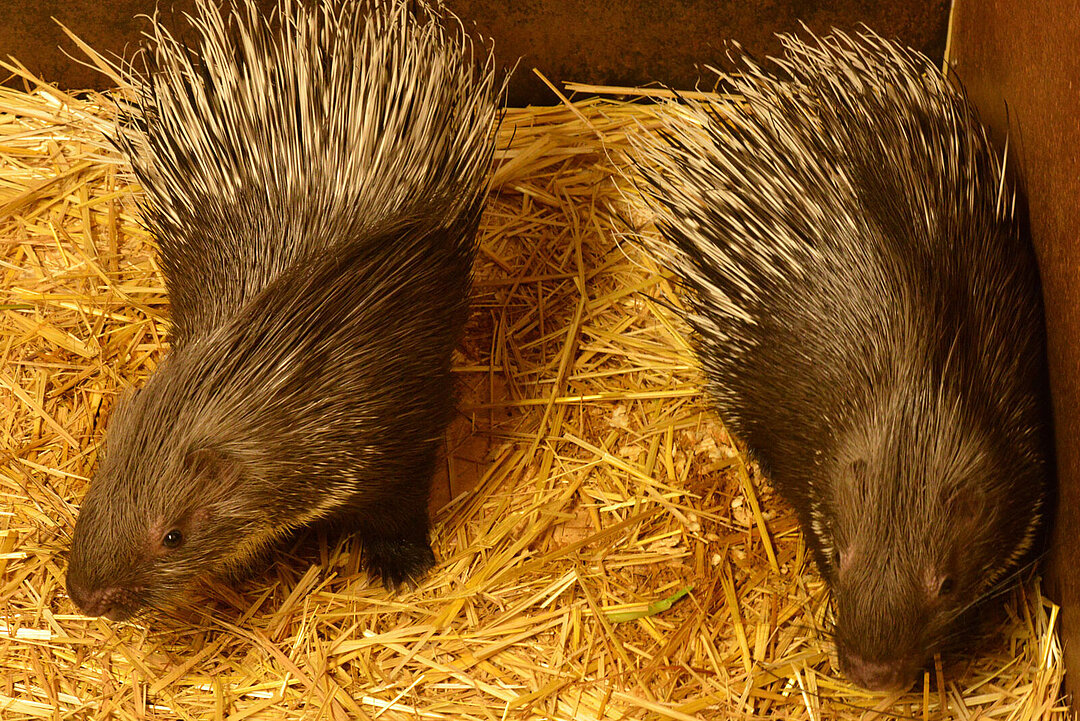![[Translate to English:] Stachelschweine in Baumstumpf.](/fileadmin/_processed_/b/9/csm_tierpark-hellabrunn-nachwuchs-stachelschweine-muenchen_be59dadee0.jpg)
Great joy at Hellabrunn: In early April, two Indian crested porcupines were born in the Munich zoo.
The super cute twins emerged from their birthing den for the first time in mid-May and have just undergone their first health check. The results of the examination conducted last week by the vets determined the sex and weight of the prickly infants – after which they were given names. The newborns particularly enjoy lying with their parents in a cosy tree hollow in the enclosure during the day. At the beginning of spring, visitors were unable to see any sign of life in the porcupine enclosure: there was not a single animal to be seen, no matter what time of day they passed by. But behind the scenes in the porcupines’ den, the reason for the lack of activity became apparent: after a gestation period of approximately 112 days, Hellabrunn’s female porcupine gave birth to two cute porcupettes. For the next few weeks, the twins, named Xüßer and Xenf, remained snuggled up with mum and dad in the comfort of their den, before making their first foray outdoors in mid-May under the watchful eye of their parents.
The twins passed the first health check with flying colours. The vets revealed that both baby porcupines are male - and are developing well. Xüßer weighs 3.8 kg and his brother Xenf weighs 4.4 kg. At birth, a porcupette‘s quills are still very soft and only begin to harden after about two weeks. The stomach area of a porcupine is very sensitive, especially among the young. For this reason, a decision was made by the veterinary team to wait until the summer before conducting the first health check.
The birth of the twins came as a pleasant surprise for Carsten Zehrer, head of zoology and curator at Hellabrunn Zoo: "My colleagues from animal care discovered the two babies during a routine morning check of the den. After that, we decided to give the animals some privacy. The keepers in charge made a point of keeping their distance, while at the same time closely monitoring the offspring’s development as well as the behaviour of the adults towards their young. As this is the second time the parents have given birth, we were able to quickly establish that both the mum and dad were once again doing a splendid job of caring for their offspring - which is always a great relief for us. In the first few months after birth, porcupine parents typically keep their offspring between them when foraging for food, as well as when they are sleeping, in order to ensure their little ones are well protected."
For zoo director and board member Rasem Baban, the two porcupettes are a reason to celebrate: "The birth of the first twins to our Indian crested porcupines is really something special for Hellabrunn Zoo, especially after the breeding success of the very first offspring last year. It shows us that the two adults feel very at home in their enclosure. Indian crested porcupines are classified as Least Concern. Nevertheless, we would like to make all our visitors aware that we still need to work together to protect not only the animals, but also their natural habitats.”
Rattling threat with soft and hard spines
A myth that persists is that porcupines can shoot their quills at predators when threatened. This is not true! Porcupines have poor vision. Instead they rely on their acute sense of smell and hearing to find their way around. When threatened, they raise their long quills to appear larger and to intimidate potential enemies. In addition to this defence strategy, they also use the small, hollow rattle quills at the base of their tail to produce a hiss-like rattle intended to ward off enemies. And if that fails, they will charge backwards into the enemy and ram their quills into the attacker's body. The spines are made of keratin, the same substance that makes up our fingernails and hair. Depending on the weather, visitors will now be able to catch a glimpse of the prickly twins in the porcupine enclosure, opposite the Giraffe Savannah at Hellabrunn.
